#union parade
Text

"MAY DAY PARADE PERMIT GRANTED BY POLICE BOARD," Toronto Star. April 30, 1934. Page 1 & 2.
---
Draper Is Ordered to Allow March From Riverdale Park
----
ONLY ONE GRANTED
----
May Day Conference Plan to March From Trinity Park Also Is Banned
----
Chief Constable D. C. Draper was instructed by the police commission to-day to allow a May Day parade by members of the May Day conference from Riverdale Park to Queen's Park along the shortest possible route, Carlton St., College St., and University Ave.
The chief constable was also instructed to provide sufficient police officers to see that the parade is conducted in an orderly manner. This will be the only parade or route of parade allowed.
Members of the conference sought permission to assemble in Trinity and Riverdale parks and converge on Queen's Park. They were told, however, that Trinity Park is not one of those designated by civic by- law as a park where meetings may be held. As an alternative, they asked for Staniey Park, but use of this had already been granted granted to the International Clothing Workers.
Warned Against Disturbance
"The secretary was authorized to issue a statement regarding the route of the parade which would be followed, and inviting persons in the parade to conduct themselves in an orderly manner so there will be no interference with traffic or the public and no damage to any property." J. Palmer Kent, secretary, announced after the session of almost two hours' duration.
"If there is any disturbance of the peace or interference with traffic, the persons in the parade must expect that the police will enforce the law and they must not hold the authorities responsible for the consequences," said the announcement.
Representing the International Clothing Workers and other unions, Con. James Simpson told the commission the organizations he was representing have abandoned their intentions of holding a parade on May Day.
As an alternative, Con. Simpson asked permission to meet in Wellington park. As the by-law does not permit meetings in this park, Parks Commissioner Chambers was called and said he would give permission for a meeting in Stanley park.
"Con. Simpson stated that the organizations represented by him must be distinguished from those organizations associated with the United May Day conference," said the announcement by the commission." He desired to disassociate the organizations represented by him from any connection with the United May Day conference, composed of organizations have Communistic ideas."
All Police On Duty
All police leave for all branches of the Toronto police force was ordered cancelled for to-morrow, and all the force is to stand by for May Day duty.
Except at police headquarters, there was no perturbation about May Day celebrations.
Preparations of police and troops in major cities throughout the world to maintain order Tuesday had no effect on Col. C. H. Hill at military headquarters. "No military preparations are being made in Toronto," he laughed, and stated that he did not expect anything out of the usual, which police are quite capable of handling. No leave would be cancelled for the detachments of the Royal Canadian Regiment and the Royal Canadian Dragoons at Stanley Barracks, he said.
Indications that Chief Constable Draper, however, intended major operations as usual were apparent at police headquarters, when the inspectors of divisions were called to conference and detailed orders were given about secret police concentrations to prevent especially the rallying of any parade at Trinity Park. which the chief in a letter to the United May Day conference several days ago expressly forbade.
Scarboro police told The Star they had heard of no May Day demonstration teing planned in Scarboro township. They have taken no action to prevent any possible demonstration.
#toronto#may day#may day parade#union parade#union men#textile workers#textile union#law and order politics#labour socialism#communists#communist party of canada#working class culture#working class politics#great depression in canada#crime and punishment in canada#history of crime and punishment in canada
0 notes
Text



Vasiliy Belyayev, {1945} Всесоюзный парад физкультурников (All-Union Parade of Athletes)
#film#gif#vasiliy belyayev#Всесоюзный парад физкультурников#all-union parade of athletes#1945#documentary#feature film#colour#soviet cinema#soviet union#cccp#male filmmakers#1940s#people
146 notes
·
View notes
Text





I need to go to a pride parade on Ferrix. do you see it. do you see the vision.
#Star wars#Ferrix#Andor#Cassian Andor#Brasso#Oats.png#comics#myart#please take a minute with me to think about this backwater union town’s potential for the most banger pride parade youve seen#not a corporate sponsor in sight. Just carabiner wearing space scrappers and peace and love in the galaxy.
127 notes
·
View notes
Text
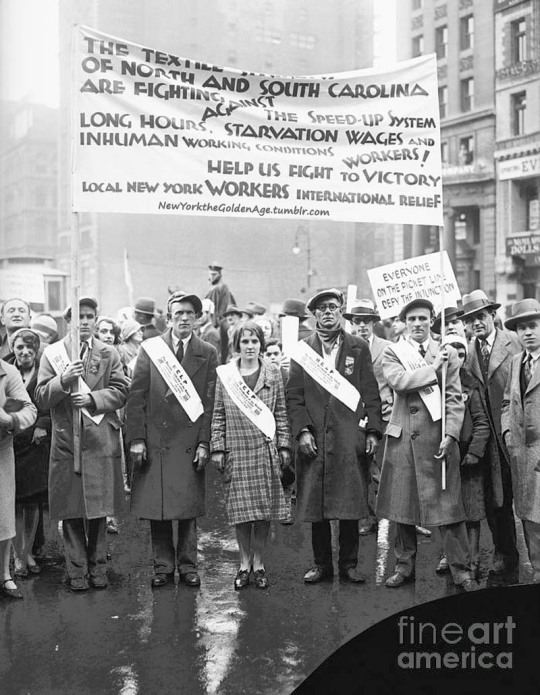
For years, May 1 was celebrated as International Workers' Day, also known as Labor Day in some countries, and often referred to as May Day. Here, in 1929, these five South Carolinan textile strike leaders marched in the Communist May Day Parade at Union Square. They carried signs, some of which pleaded for help, and others read, "Everyone on the picket line! Defy the Injunction!" May Day in New York passed quietly.
Photo: Bettmann Archive/Getty Images/Fine Art America
#vintage New York#old NY#1920s#1 May#May 1#May Day#workers#labor#unions#strikes#collective bargaining#parade#Communism#Union Square
464 notes
·
View notes
Text

Ceremonies - Salutes and Parades - New York - Thousands march in New York's Labor Day Parade
Record Group 165: Records of the War Department General and Special StaffsSeries: American Unofficial Collection of World War I PhotographsFile Unit: Ceremonies - Salutes and Parades - New York
Original Caption: Thousands march in New York's Labor Day Parade. Many thousands marched in New York's Labor Day Parade, which was unquestionably the largest of its kind ever held. View of the parade coming up Fifth Avenue, is given.
Date Taken: 9/2/1918
Photographer: New York World
This black and white photograph shows men in suits and hats of the style of 1918 marching on a large street. Each carries an American flag. In the center of the group is a sign that says “Local No. 44.” A crowd of men and women watch from the sidewalk. The parade continues in the distance.
31 notes
·
View notes
Text

SOURCE
Parade workers at Disneyland expressed concern over being asked to resume hugging visitors during the pandemic, while facing allegations of inadequate wages and work conditions.
The Actors' Equity Association will represent the workers in discussing improvements to health, safety, wages, benefits, working conditions, and job security.
Disney cast members' dreams came true as they formed a union to address concerns such as injuries from costumes and erratic schedules.
#sulemio news#sulemio#suletta mercury#miorine rembran#g-witch#g witch#disneyland#disney parade#disney workers#disney employees#disney union#unionize#us government#us news#california news#us labor
32 notes
·
View notes
Photo

Lev Borodulin. Ornament of Sport. Moscow, USSR. 1956
Follow my new AI-related project «Collective memories»
#BW#Black and White#Preto e Branco#Noir et Blanc#黒と白#Schwarzweiß#retro#vintage#Lev Borodulin#Sports#death parade#Moscow#USSR#URSS#Soviet Union#Union Sovetique#1950s#1956#50s
36 notes
·
View notes
Text
1 may 1941
There is war in Europe. Thousands of victims. Stalin hosts the parade on Red Square. The guests of honor of the parade are the allies of the USSR - the Third Reich.
17 notes
·
View notes
Text

President James Garfield observes the Inaugural Parade on Pennsylvania Avenue from a reviewing stand temporarily erected in front of the White House, March 4, 1881.
The procession of soldiers marching in the parade -- led by commanding General William Tecumseh Sherman -- to celebrate President Garfield's Inauguration was believed to be the largest collection of troops in Washington, D.C. since the Grand Review of the Armies in May 1865 which commemorated the Union victory in the Civil War.
#History#Presidents#James Garfield#President Garfield#Garfield Administration#Inauguration of James Garfield#Garfield Inauguration#Inauguration of 1881#Washington D.C.#White House#White House History#Presidential History#Presidential Inaugurations#Inaugurations#Inaugural Parades#Grand Review of the Armies#Grand Review of the Union Army#Civil War#Presidency#William Tecumseh Sherman#General Sherman#James A. Garfield
20 notes
·
View notes
Photo
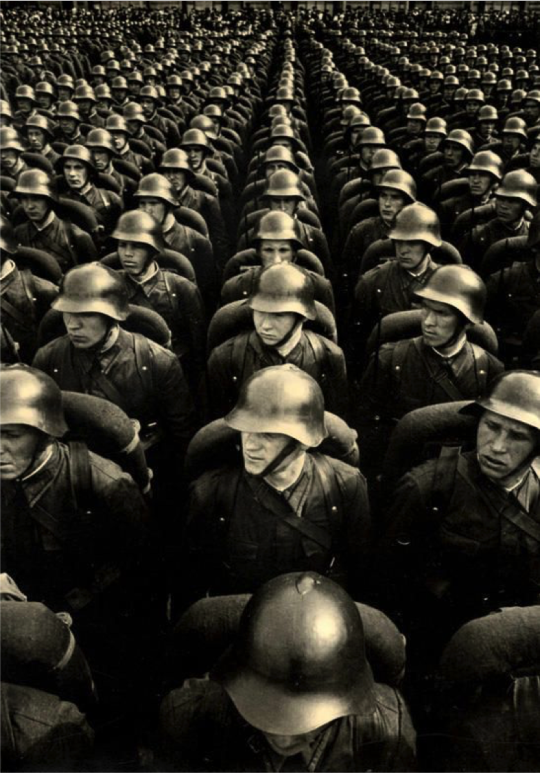
Défilé de l'Armée Rouge – Place Rouge – Moscou – Union soviétique – 1936
Photographe : Georgy Petrusov
#Avant-guerre#Pre-war#Armée soviétique#Soviet army#Armée rouge#Red Army#Parade militaire#Military parade#Gueorgui Petroussov#Georgy Petrusov#Place Rouge#Red Square#Moscou#Moscow#Union soviétique#Soviet union#1936
69 notes
·
View notes
Text

Staff officers and officer-scholars of Soviet military academies marching through Red Square in the 1982 Moscow October Revolution Day Parade.
2 notes
·
View notes
Text



Nikolay Solovyev, {1938} Цветущая молодость (Blooming Youth)
#film#gif#nikolay solovyev#Цветущая молодость#blooming youth#1938#soviet cinema#short film#documentary#propaganda#colour#1930s#soviet union#cccp#parades#people
13 notes
·
View notes
Text
everyone else in america: happy 4th!
me vc: yeahhhh i could live being british rn
#;out of webs#;mun rambles#((i’m going to a parade but i’ll be back!))#((i wish i had a union jack shirt rn—bc i am a little shit and like to bring chaos 💕))
16 notes
·
View notes
Text
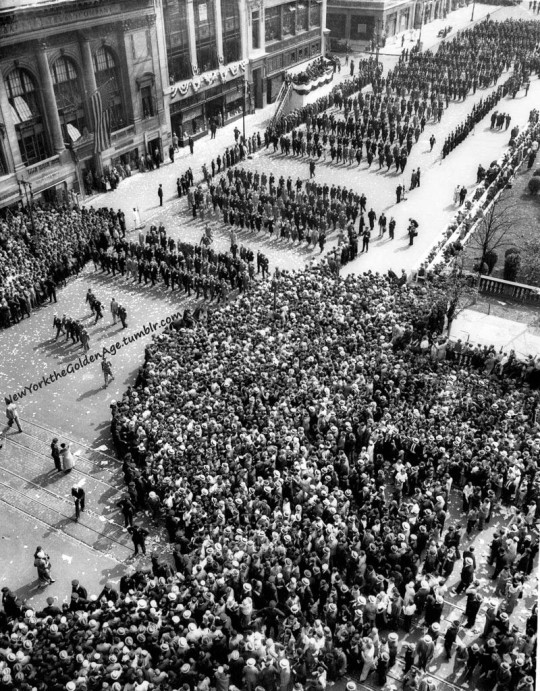
In the 1930s, "NRA" stood for the National Recovery Administration, established by President Franklin D. Roosevelt in 1933 as part of his New Deal. Its goal was to allow businesses get together to write "codes of fair competition" that would help workers set minimum wages and maximum weekly hours, as well as minimum prices at which products could be sold.
That the NRA was popular with workers is shown above by the turnout for a parade in its honor on Fifth Avenue on September 13, 1933. But two years later, the Supreme Court ruled it unconstitutional, and it was disbanded. However, many of its provisions resurfaced in the National Labor Relations Act of 1935. The end result was a surge in the growth and power of unions.
Photo: Associated Press
#vintage New York#1930s#New Deal#NRA#National Recovery Administration#FDR#parade#unions#crowd#Fifth Ave.#5th Ave.#vintage NYC#employment#September 13#13 September#13 Sept.#Sept. 13
61 notes
·
View notes
Text
Second time in about 48 hours that I have gone into the search mines to bring out a specific pride flag for my blog only to be met with either long or thoughtless posts about how x flag is the most inferior or y flag is the most superior while shitting on other flag designs. Like, I am all for making as many flags as you want — the more the merrier no monopolies here. I would just like for people to keep in mind:
Which communities (including geographical and cultural!!!) specific flags come from and why they were created.
You do not need to be represented by every single stripe for the flag to be applicable to you.
If a flag is featuring a specific identity there's probably a reason for that, I don't care if it's ugly.
Please cite sources and inspiration! Flags represent communities and usually come from community involvement and influence.
Seriously unless a flag was made purposefully to demean or alienate others it's probably fine. You don't have to use it or prefer it and you can be annoyed with it but it doesn't mean it's the end of the world.
#Apparently the polyam flag was '''''''''“officially'''''''''''' redesigned a year ago and I don't even consider polyamory to be#_inherently_ queer but I don't consider leather to be _inherently_ queer either and like the leather pride flag was like the second ever#pride flag and was used in a Pride parade across the country from where it was designed less than a month after it was revealed.#Anyways it's fine if aromantic or other polyamorous people don't feel like they have infinite love but#a) π is not infinite it is _irrational_ and it's decimal _expression_ is infinite and#b) π is literally just the Greek letter p‚ like the Greek rootword poly πολύς.#If you aren't a Black or brown person from Philadelphia then I don't really think it's your place to reject the Philly Pride flag.#Yes there has previous been a black stripe on a rainbow flag to represent AIDS. Colors can mean multiple things. The spectrum for visible#color for humans is only so broad and we are so good at coming up with meaning and nuance.#People talk about ''Queer is a slur.'' being a TERF talking point but I don't see nearly enough people talking about#''Not all intersex people want to be included in LGBTQIA+.'' as one too. I rarely ever see this coming from intersex people and I have#NEVER seen it on a post actually about intersex rights. It's always a throw-away comment when they're criticizing other queer people.#I'm agender and don't consider myself trans. It's fine if specific intersex people don't consider themselves queer. The I still belongs.#And even if it DIDN'T that would mean the Intersex-Inclusive Progress Pride Flag has MORE reason for existing not less.#If intersex people aren't inherently included in the rainbow flag then that means a flag representing the union of queer people and#intersex people has a PURPOSE and isn't redundant.#personal#...I might have used too many tags so that might not show on my blog. I forget if the limit is 14 or 20.#I just wanted to reblog pictures of the πolyamory flag and the 2017 Gilbert Baker nine-stripe rainbow flag and here I am getting annoyed#and irritated.#Ugh this is probably gonna show in search results too because I didn't censor anything.#Well while I'm pissing people off I will give my hot take that the biggest crime of the leather‚ trans‚ and lipstick lesbian pride flags is#all these dang white stripes in the center.#Other hot takes: More people need to take a leaf from the bi flag and vary their stripe widths please.#Also while it can easily be overdone‚ I like the symbols in the corner of the leather ❤‚ bear 🐾‚ and lipstick lesbian 💋 flags.#Also hot take I've posted before: the 8- or 9-stripe rainbow flags and the sunset lesbian flag can be for you even if you're ace and/or#sex repulsed. The flags aren't like... criteria for an identity. Not to bring up something horrible like the US empire but you don't have#to have lived in one of the thirteen colonies for those red and white stripes to still represent you.#I hate that the TERFs use the colors of the suffragette flag in heart emojis 💜🤍💚 and that those colors are so similar to the genderqueer#flag (a coincidence on the part of the creator of the genderqueer flag).
7 notes
·
View notes
Text
‘Africa Is Fighting, Africa Will Win’: How Soviet Art Supported the Decolonization of the ‘Dark Continent’
The liberation of Africa from the oppression of Western colonizers in the 1960s became one of the main themes of Soviet propaganda posters
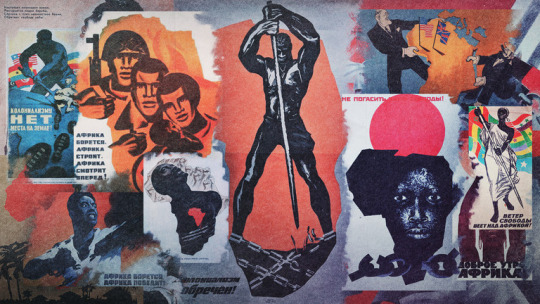
In the second half of the 20th century, the African continent lived through its own ‘parade of sovereignties.’ In 1960 alone, 17 new nations gained independence in what was formerly colonial Africa. While remaining economically dependent on Europe, the former colonies fought for political independence. The USSR tried to provide them with as much assistance as possible and in fact initiated the adoption of the Declaration on the Granting of Independence to Colonial Countries and Peoples at the 15th session of the UN General Assembly. At that time, a point appeared in the Program of the Communist Party of the Soviet Union, the main strategic policy document of the country, stating that “the national liberation movement is one of the main anti-imperialist forces.”
In addition to providing diplomatic, economic, and military assistance to anti-colonial movements in Africa, the USSR also made use of propaganda. From images of a black slave breaking shackles, to depictions of an international union of workers of all skin colors, and the black population shown groaning under the oppression of white colonizers, African themes became an integral part of Soviet propaganda posters.
At the second Russia-Africa Summit, which opened in St. Petersburg on Wednesday, the pavilions were decorated with Soviet posters exploring the decolonization of the African continent. Below, we’ve assembled some of the most interesting images.

Top Left: The creator of this poster is acclaimed Soviet artist Viktor Koretsky, who made over 40 emotionally charged posters during the Second World War. In the 1960s, the struggle against colonialism in Africa became one of his main themes. The inscription on this poster says, “Freedom to all nations of Africa!”
Top Right: One of the first posters showing the struggle of African nations against Western colonizers was created in 1960 by a group of Soviet graphic artists known as Kukryniksy.The image of a black man who strangles his former oppressor with broken chains is accompanied by an inscription that says, “The nations of Africa will rein in colonizers!”
Bottom: This poster, also by Koretsky created in the style of socialist realism, shows a black man breaking the shackles that bind him. The inscription says, “Africa is fighting, Africa will win!”
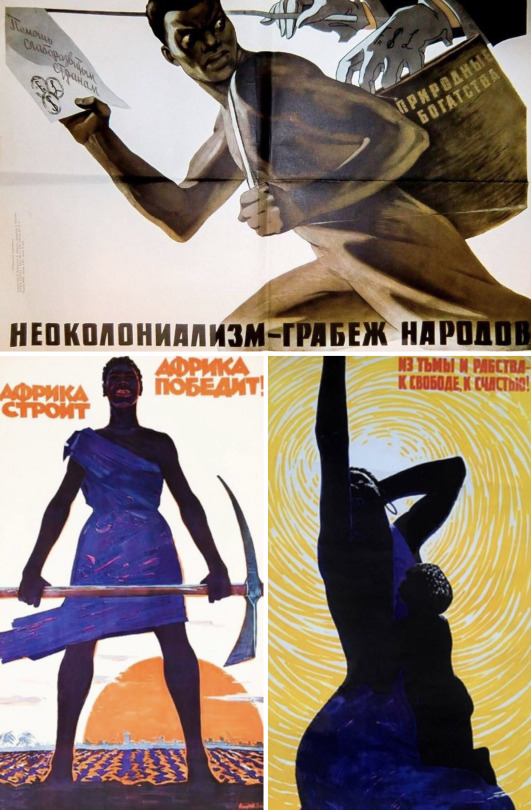
Top: Another poster by Koretsky depicts a black man who received a paper from Western countries promising “aid to underdeveloped countries.” However, glancing back, he sees how the same hands that gave him the paper are trying to steal from a basket inscribed with the words “natural resources.” The inscription reads “Neocolonialism is the plunder of nations.”
Bottom Left: The conflict between the oppressors and the oppressed was not the only theme that emerged in Soviet posters of the time. Artists often explored the constructive side of decolonization. For example, this poster is by Soviet-Armenian painter Eduard Artsrunyan, a major figure in modern Armenian art. The work was created at the very beginning of his career, shortly after he graduated from the Institute of Art. The image of a young African man ready to build a happy future in his homeland is accompanied by the inscription, “Africa is building. Africa will win!”
Bottom Right: Artsrunyan created another poster on the same theme two years later, in 1965. This one features an African mother – another popular image for Soviet artists. “Out of darkness and slavery – to freedom, to happiness,” says the inscription.

Left: This poster, created by the artist couple Vladimir and Irina Kalensky in 1961, was dedicated to the parade of sovereignties on the African continent. The inscription on the poster, which shows a black girl bearing the flags of the newly formed nations, says, “The wind of freedom is blowing over Africa!”
Middle: This 1960 poster, made by artists Oleg Maslyakov and Efim Tsvik, also avoids direct political slogans. Instead, it looks forward to a new beginning for the African continent as it awakens from its colonial slumber. “Good morning, Africa,” reads the inscription.
Right: A work by Nina Vatolina, the creator of the famous Soviet poster “Don't chatter”, picks up the theme of the previous poster five years later in 1965. The inscription reads “We live in a free Africa!”
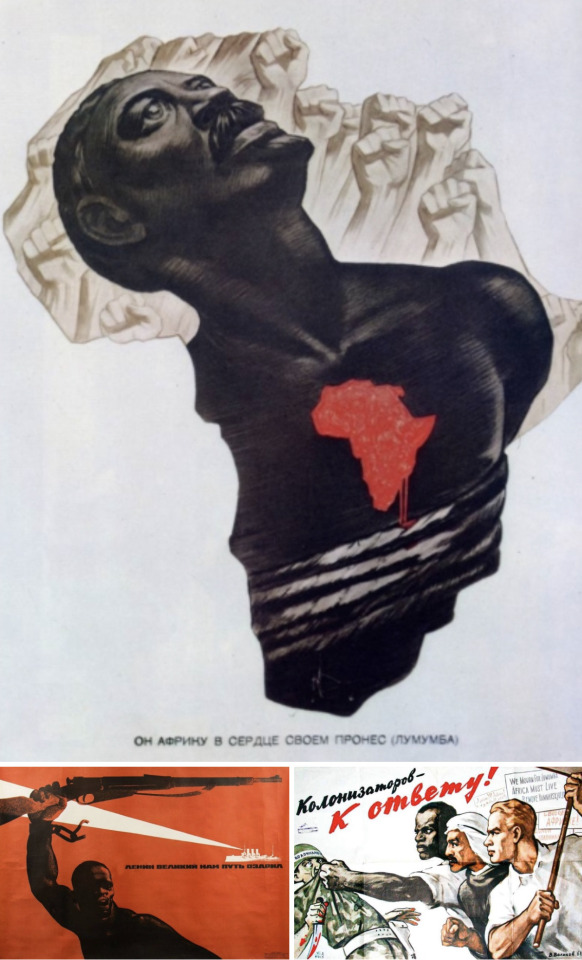
Top: Some of the works of Soviet graphic artists were devoted to prominent figures of the African liberation movement. For example, this one by Viktor Koretsky is dedicated to the memory of the independence fighter and first prime minister of the Democratic Republic of Congo Patrice Lumumba, who was killed in 1961. Lumumba is shown against the silhouette of the African continent and with the same silhouette in his heart. It is accompanied by the inscription, “He carried Africa in his heart.”
Bottom Left: Many poster artists drew parallels between the October Revolution in Russia and the liberation movement in Africa. For example, this 1969 poster by Vasily Boldyrev shows a young black man with a rifle illuminated by the light of the Soviet cruiser Aurora – one of the main symbols of the Russian Revolution. “The Great Lenin has illuminated our path,” reads the inscription.
Bottom Right: Lumumba is also mentioned in a work by poster artist Vadim Volikov titled ‘Hold the colonizers to account!’ It shows African and Arab liberation fighters with a Russian proletarian. Together, they threaten a serviceman clutching a blood-covered knife and bearing the inscription “colonialism" on his helmet. The fighters against colonialism hold posters in three languages, which proclaim:
– We mourn for Lumumba, Africa must live, Remove Hammarskjöld! – [Arabic] Down with colonialism, victory to the peoples! – [Russian] Down with colonialism, free Africa!
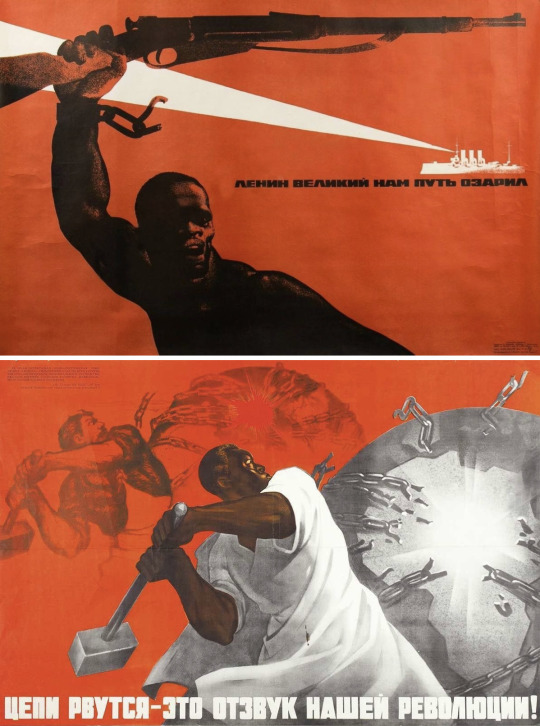
Top: Many poster artists drew parallels between the October Revolution in Russia and the liberation movement in Africa. For example, this 1969 poster by Vasily Boldyrev shows a young black man with a rifle illuminated by the light of the Soviet cruiser Aurora – one of the main symbols of the Russian Revolution. “The Great Lenin has illuminated our path,” reads the inscription.
Bottom: This work created jointly by Viktor Koretsky and Yuri Kershin in 1967 shows an African independence fighter as a mirror image of a Russian proletarian revolutionary. The poster bears a quote from the theses adopted by the Central Committee of the USSR’s Communist Party for the 50th anniversary of the October Revolution:
”The Great October Socialist Revolution dealt a severe blow to the entire system of imperialist colonial rule, and became a powerful stimulus for the development of the national liberation movement.”
The inscription states, “The chains are breaking – this is an echo of our revolution!”

Left: This work by Vladimir Menshikov belongs to the late school of Soviet poster art – it was created in 1980, when the Cold War had entered a new stage of tension. The man depicted in the lower left-hand corner holds a flag with the inscription “Give us freedom!” The image is accompanied by a Poem:
The time of retribution is coming,
The flames of battle flare up;
Throwing off the despised load from their shoulders,
Slaves gain freedom
Middle: This 1967 poster by Soviet and Russian artist of Azerbaijani origin Vilen Karakashev shows the irreversibility of the anti-colonial movement in Africa. “You cannot extinguish the dawn of freedom!” the poster says.
Right: A poster by artist Nikolay Smolyak from 1961 depicts a young African man ‘shoveling out’ a colonialist, who leaves behind footprints bearing the words “slavery, robbery, hunger and terror” on African soil. The inscription says,“Colonialism has NO place on Earth!”
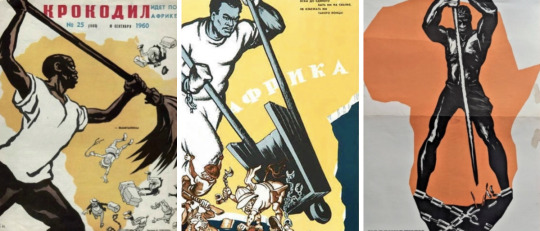
Left: In the USSR, the campaign supporting the African struggle against Western colonial powers was backed not only by individual artists, but also by various publications. For example, this is the cover of the September 1960 issue of the satirical magazine ‘Crocodile’. “Clear out!” says a dark-skinned young man with a broom, banishing Western oppressors from his continent.
Middle: A similar theme is explored by Alexander Vyaznikov and Vasily Fomichev in a poster created in 1972. It is accompanied by a Poem:
Old-school colonizers
As well as modern ones
Should all be sent to the dump
Such is their fate!
Right: The political regime in South Africa, where the Apartheid system even outlasted the USSR, came in for particularly sharp criticism by Soviet artists. In this poster by Eduard Artsrunyan, a black man is trying to break chains that resemble the borders of South Africa. “Colonialism is doomed!” says the inscription.
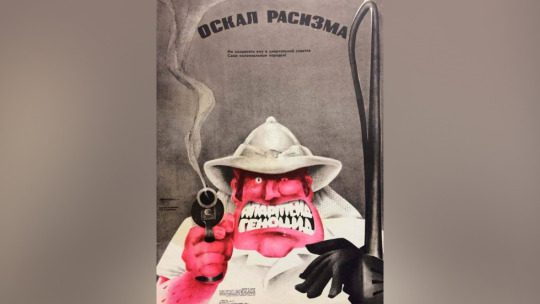
A 1978 poster titled ‘The Grin of Racism’ by artist Fyodor Nelyubin touches on the same theme. He portrays an embittered colonizer whose sinister smile spells out the words “apartheid” and “genocide.” The work is accompanied by a Short Poem:
In this deadly fight he won’t retain
His old colonial ways!

Another work by Nelyubin, painted in the same year, ridicules the unwillingness of Western imperialists to understand the hostile attitude demonstrated towards them by Africa’s local population. The poster titled ‘Black Ingratitude’ is accompanied by a Poem:
Malicious alarm spreads in the racist camps
Foster is angry, indignant is Smith:
We’ve done so much for the Blacks
But all they shout is “Down with apartheid!”
— By Georgiy Berezovsky, Vladikavkaz-based Journalist | RT | 26 July, 2023
#Africa#Soviet Union – USSR#Dark Continent#Decolonization#Libration#Libration of Africa#Western Colonizers#Soviet Propaganda Posters#20th Century#Parade of Sovereignties#UN General Assembly#Russia-Africa Summit#St. Petersburg
3 notes
·
View notes